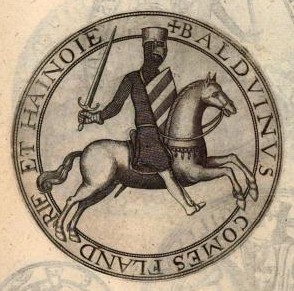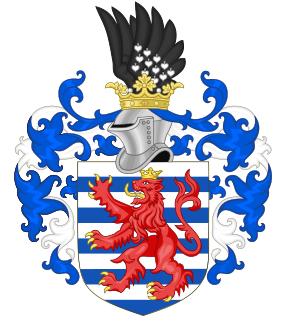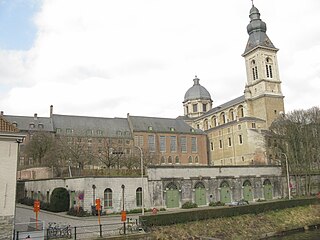The count of Flanders was the ruler or sub-ruler of the county of Flanders, beginning in the 9th century. The title was held for a time by the rulers of the Holy Roman Empire and Spain. During the French Revolution, in 1790, the county of Flanders was annexed to France and ceased to exist. In the 19th century, the title was appropriated by Belgium and granted twice to younger sons of Belgian kings. The most recent holder died in 1983.
Baldwin IV, called the Bearded, was the count of Flanders from 987 until his death.

Baldwin V was count of Flanders from 1035 until his death. He secured the personal union between the counties of Flanders and Hainaut and maintained close links to the Anglo-Saxon monarchy, which was overthrown by his son-in-law, William the Conqueror, near the end of his life.

The County of Hainaut, was a territorial lordship within the medieval Holy Roman Empire, straddling what is now the border of Belgium and France. Its most important towns included Mons, now in Belgium, and Valenciennes, now in France.

Baldwin V of Hainaut was count of Hainaut (1171–1195), margrave of Namur as Baldwin I (1189–1195) and count of Flanders as Baldwin VIII (1191–1195).
Godfrey III, called the Bearded, was the eldest son of Gothelo I, Duke of Upper and Lower Lorraine.

The Limburg-Luxemburg dynasty, one of several families from different periods known as the Luxembourg dynasty was a royal family of the Holy Roman Empire in the Late Middle Ages, whose members between 1308 and 1437 ruled as kings of Germany and Holy Roman emperors as well as kings of Bohemia, Hungary and Croatia. Their rule was twice interrupted by the rival House of Wittelsbach.

Gertrude of Saxony, also known as Gertrude Billung, was a countess of Holland by marriage to Floris I, Count of Holland, and countess of Flanders by marriage to Robert I, Count of Flanders. She was regent of Holland in 1061-1067 during the minority of her son Dirk V, and regent of Flanders during the absence of her spouse in 1086-1093.
Frederick of Luxembourg, Count of Moselgau, was a son of Siegfried of Luxembourg and Hedwig of Nordgau.
The House of Ardenne-Verdun was a branch of the House of Ardenne, one of the first documented medieval European noble families, centered on Verdun. The family dominated in the Duchy of Lotharingia (Lorraine) in the 10th and 11th centuries. All members descended from Count Palatine Wigeric of Lotharingia and his wife Cunigunda of France, a granddaughter of the West Frankish king Louis the Stammerer. The other main branches of the House of Ardennes were the House of Ardenne-Luxembourg, and the House of Ardenne-Bar.
Eleanor of Normandy was a Countess consort of Flanders. She was born between the years 1011 and 1013 in Normandy, the daughter of Richard II, Duke of Normandy and his wife, Judith of Brittany. Eleanor had two sisters and three brothers, including Robert I, Duke of Normandy, whose illegitimate son was William the Conqueror. In 1017, when Eleanor was still a child, her mother Judith died. Duke Richard married secondly Poppa of Envermeu, by whom he had two more sons.

Isabelle of Luxembourg (1247–1298) was a countess consort of Flanders and a marquis consort of Namur by marriage to Guy of Dampierre.

The House of Flanders—also called the Baldwins —was a medieval ruling family founded by Baldwin I Iron Arm, son-in-law of Charles the Bald.

The Dampierre family played an important role during the Middle Ages. Named after Dampierre, in the Champagne region, where members first became prominent, members of the family were later Count of Flanders, Count of Nevers, Counts and Dukes of Rethel, Count of Artois and Count of Franche-Comté.
Godfrey of Namur was a Lotharingian nobleman. He was Count jure uxoris of Porcéan from 1097 until his death. From 1102, he was also Count of Namur. He was the oldest son of Count Albert III and his wife Ida of Saxony, the heiress of Laroche.
Henry I (c.1200–1252) was the hereditary Count of Vianden from 1210 and, through his wife, Marquis of Namur from 1229.

Henry V the Blondell, called the Great, was the count of Arlon from 1226 to his death, lord of Ligny from 1240 to his death, count of Luxembourg and Laroche from 1247 to his death, and the count of Namur between 1256 and 1264 as Henry III. He was the son and successor of Waleran III of Limburg and Ermesinda of Luxembourg.

Saint Peter's Abbey is a former Benedictine abbey in Ghent, Belgium, now a museum and exhibition centre.
The Army of Godfrey of Bouillon was created by Godfrey, Lord of Bouillon, and Duke of Lower Lorraine, in response to the call by Pope Urban II to both liberate Jerusalem from Muslim forces and protect the Byzantine Empire from similar attacks. Godfrey and his army, one of several Frankish forces deployed during the First Crusade, was among the first to arrive in Constantinople. The army was unique in that it included among its warriors the first three kings of Jerusalem, although Godfrey preferred the title Defender of the Holy Sepulchre, Advocatus Sancti Sepulchri, as he believed that the true King of Jerusalem was Christ. This article focuses on the members of the army rather that its exploits which are described in detail in Godfrey’s biography as well as numerous sources listed below.
The House of Luxembourg , also known as the House of Ardenne-Luxembourg in order to distinguish it from later families, were a Lotharingian noble family known from the tenth and eleventh centuries. They are one of the three main branches of the House of Ardenne, along with the House of Ardenne-Verdun, and the House of Ardenne-Bar.












